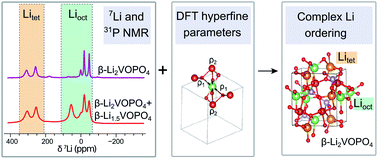Evolution of lithium ordering with (de)-lithiation in β-LiVOPO4: insights through solid-state NMR and first principles DFT calculations†
Abstract
The lithium-ion battery cathode material β-VOPO4 is capable of intercalating more than one Li ion per transition metal ion due to the accessibility of both the V5+/V4+ and V4+/V3+ redox couples at ∼4.5 V and ∼2.3 V vs. Li, respectively, giving a theoretical capacity greater than ∼300 mA h g−1. The ability to perform full and reversible two Li-ion intercalation in this material, however, has been a matter of debate and the poor crystallinity of the fully lithiated phase has thus far precluded its complete structural characterisation by conventional diffraction-based methods. In this work, 7Li and 31P NMR spectroscopy, in combination with first principles DFT calculations, indicate that chemical lithiation results in a single phase β-Li2VOPO4 exhibiting a complex Li ordering scheme with lithium ions occupying multiple disordered environments. 2D NMR 7Li correlation experiments were used to deduce the most likely Li ordering for the β-Li2VOPO4 phase from amongst several DFT optimised structures. In contrast, electrochemically lithiated β-Li2−xVOPO4 discharged to 1.6 V exhibits, in addition to β-Li2VOPO4, a β-Li1.5VOPO4 phase. The existence of β-Li1.5VOPO4 is not reflected in the flat galvanostatic charge and discharge curves nor is evident from diffraction-based methods due to the very close structural similarity between the β-Li1.5VOPO4 phase and β-Li2VOPO4 phases. We demonstrate that solid state NMR spectroscopy, in combination with DFT results, provides a powerful tool for identifying intermediate states formed during charge/discharge of these complex phosphates as these phases can be distinguished from the end member phases primarily by the nature of the lithium ordering.



 Please wait while we load your content...
Please wait while we load your content...